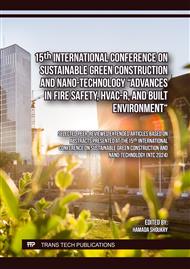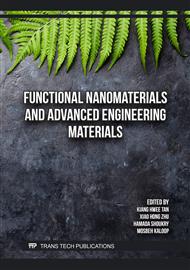[1]
H.M. Abdeldayem, M.A. Sayed, Synthesis and characterization of Ag/Ce1-XBiXZnO composites hosted α-β/Bi2O3 as highly efficient catalysts for degradation of cationic and anionic dyes, Journal of Photochemistry and Photobiology A: Chemistry, 427 (2022) 113773.
DOI: 10.1016/j.jphotochem.2022.113773
Google Scholar
[2]
M.A. Sayed, W. Abdelmaksoud, S.M. Teleb, A.M. El-Din, M.M. Abo-Aly, Low-cost fabrication and physicochemical characterization of ZnFe2O4 nanoparticles as an efficient multifunctional inorganic pigment, Journal of Coatings Technology and Research, 20 (2023) 1997-2006.
DOI: 10.1007/s11998-023-00793-4
Google Scholar
[3]
H. Yang, H. Cui, W. Tang, Z. Li, N. Han, F. Xing, A critical review on research progress of graphene/cement based composites, Composites Part A: Applied Science and Manufacturing, 102 (2017) 273-296.
DOI: 10.1016/j.compositesa.2017.07.019
Google Scholar
[4]
M.S. El-Feky, A. Mohsen, A. Maher El-Tair, M. Kohail, Microstructural investigation for micro - nano-silica engineered magnesium oxychloride cement, Construction and Building Materials, 342 (2022) 127976.
DOI: 10.1016/j.conbuildmat.2022.127976
Google Scholar
[5]
M.M. Wetwet, S.M.A. El-Gamal, M. Ramadan, M.M. Hazem, Multifunctional cementitious blends containing zirconia nanoparticles: Mechanical characteristics, gamma attenuation behavior, and self-cleaning performance, Journal of Building Engineering, 65 (2023) 105736.
DOI: 10.1016/j.jobe.2022.105736
Google Scholar
[6]
M. Ramadan, M. Kohail, Y.R. Alharbi, A.A. Abadel, A.S. Binyahya, A. Mohsen, Investigation of autoclave curing impact on the mechanical properties, heavy metal stabilization and anti-microbial activity of the green geopolymeric composite based on received/thermally-treated glass polishing sludge, Journal of Materials Research and Technology, 23 (2023) 2672-2689.
DOI: 10.1016/j.jmrt.2023.01.158
Google Scholar
[7]
S.M.A. El-Gamal, S.A. Abo-El-Enein, F.I. El-Hosiny, M.S. Amin, M. Ramadan, Thermal resistance, microstructure and mechanical properties of type I Portland cement pastes containing low-cost nanoparticles, Journal of Thermal Analysis and Calorimetry, 131 (2018) 949-968.
DOI: 10.1007/s10973-017-6629-1
Google Scholar
[8]
S.A. Abo-El-Enein, F.I. El-Hosiny, S.M.A. El-Gamal, M.S. Amin, M. Ramadan, Gamma radiation shielding, fire resistance and physicochemical characteristics of Portland cement pastes modified with synthesized Fe2O3 and ZnO nanoparticles, Construction and Building Materials, 173 (2018) 687-706.
DOI: 10.1016/j.conbuildmat.2018.04.071
Google Scholar
[9]
A. Mohsen, H.A. Abdel-Gawwad, M. Ramadan, Performance, radiation shielding, and anti-fungal activity of alkali-activated slag individually modified with zinc oxide and zinc ferrite nano-particles, Construction and Building Materials, 257 (2020) 119584.
DOI: 10.1016/j.conbuildmat.2020.119584
Google Scholar
[10]
M. Heikal, N.S. Ibrahim, Hydration, microstructure and phase composition of composite cements containing nano-clay, Construction and Building Materials, 112 (2016) 19-27.
DOI: 10.1016/j.conbuildmat.2016.02.177
Google Scholar
[11]
K. Rathinam, S.S, V. S.P, V.M, N.K. U, Properties of nano silica modified cement less geopolymer composite mortar using fly ash and GGBS, Materials Today: Proceedings, 62 (2022) 535-542.
DOI: 10.1016/j.matpr.2022.03.589
Google Scholar
[12]
A. Mohsen, M. Kohail, Y.R. Alharbi, A.A. Abadel, A.M. Soliman, M. Ramadan, Bio-mechanical efficacy for slag/fly ash-based geopolymer mingled with mesoporous NiO, Case Studies in Construction Materials, 19 (2023) e02283.
DOI: 10.1016/j.cscm.2023.e02283
Google Scholar
[13]
L. Ghasemi, H. Jafari, Morphological Characterization of Tungsten Trioxide Nanopowders Synthesized by Sol-Gel Modified Pechini's Method, Materials Research, 20 (2017).
DOI: 10.1590/1980-5373-mr-2017-0467
Google Scholar
[14]
L. Zhang, H. Wang, J. Liu, Q. Zhang, H. Yan, Nonstoichiometric tungsten oxide: structure, synthesis, and applications, Journal of Materials Science: Materials in Electronics, 31 (2020).
DOI: 10.1007/s10854-019-02596-z
Google Scholar
[15]
M.A. Sayed, S.M.A. El-Gamal, A. Mohsen, M. Ramadan, M.M. Wetwet, N.M. Deghiedy, A.E. Swilem, M.M. Hazem, Towards a green climate: Production of slag–red brick waste-based geopolymer mingled with WO3 nanoparticles with bio-mechanical achievements, Construction and Building Materials, 413 (2024) 134909.
DOI: 10.1016/j.conbuildmat.2024.134909
Google Scholar
[16]
V. Dutta, S. Sharma, P. Raizada, V.K. Thakur, A.A.P. Khan, V. Saini, A.M. Asiri, P. Singh, An overview on WO3 based photocatalyst for environmental remediation, Journal of Environmental Chemical Engineering, 9 (2021) 105018.
DOI: 10.1016/j.jece.2020.105018
Google Scholar
[17]
L. Santos, C.M. Silveira, E. Elangovan, J.P. Neto, D. Nunes, L. Pereira, R. Martins, J. Viegas, J.J. Moura, S. Todorovic, Synthesis of WO3 nanoparticles for biosensing applications, Sensors and Actuators B: Chemical, 223 (2016) 186-194.
DOI: 10.1016/j.snb.2015.09.046
Google Scholar
[18]
J. Bentley, S. Desai, B.P. Bastakoti, Porous Tungsten oxide: recent advances in design, synthesis, and applications, Chemistry–A European Journal, 27 (2021) 9241-9252.
DOI: 10.1002/chem.202100649
Google Scholar
[19]
M.B. Tahir, G. Nabi, M. Rafique, N. Khalid, Nanostructured-based WO 3 photocatalysts: recent development, activity enhancement, perspectives and applications for wastewater treatment, International Journal of Environmental Science and Technology, 14 (2017) 2519-2542.
DOI: 10.1007/s13762-017-1394-z
Google Scholar
[20]
ASTMC109M-20b, Standard test method for compressive strength of hydraulic cement mortars (using 2-in. or [50-mm] cube specimens., Annual Book of ASTM Standards, (2020).
DOI: 10.1520/c0109_c0109m-11b
Google Scholar
[21]
I.M. Szilágyi, B. Fórizs, O. Rosseler, Á. Szegedi, P. Németh, P. Király, G. Tárkányi, B. Vajna, K. Varga-Josepovits, K. László, WO3 photocatalysts: Influence of structure and composition, Journal of catalysis, 294 (2012) 119-127.
DOI: 10.1016/j.jcat.2012.07.013
Google Scholar
[22]
Y. Lu, J. Zhang, F. Wang, X. Chen, Z. Feng, C. Li, K2SO4-assisted hexagonal/monoclinic WO3 phase junction for efficient photocatalytic degradation of RhB, ACS Applied Energy Materials, 1 (2018) 2067-2077.
DOI: 10.1021/acsaem.8b00168
Google Scholar
[23]
P. Shandilya, S. Sambyal, R. Sharma, P. Mandyal, B. Fang, Properties, optimized morphologies, and advanced strategies for photocatalytic applications of WO3 based photocatalysts, Journal of Hazardous Materials, 428 (2022) 128218.
DOI: 10.1016/j.jhazmat.2022.128218
Google Scholar
[24]
M. Patel, S. Manna, A. Vo, X. Xu, D. Conti, S. Choi, D. Kozak, J. Zheng, Scanning Electron Microscope (SEM) Coupled with Energy Dispersive X-ray Spectroscopy (EDS)-A Potential Analytical Tool for Physico-chemical Characterization of API in Complex Drug Formulations, Microscopy and Microanalysis, 26 (2020) 2254-2255.
DOI: 10.1017/s1431927620020978
Google Scholar
[25]
S. Rades, V.-D. Hodoroaba, T. Salge, T. Wirth, M.P. Lobera, R.H. Labrador, K. Natte, T. Behnke, T. Gross, W.E.S. Unger, High-resolution imaging with SEM/T-SEM, EDX and SAM as a combined methodical approach for morphological and elemental analyses of single engineered nanoparticles, RSC advances, 4 (2014) 49577-49587.
DOI: 10.1039/c4ra05092d
Google Scholar
[26]
H.A. Mashout, T.A. Razek, M.S. Amin, F.S. Hashem, F.A. Selim, Performance of nano titania-reinforced slag/basalt geopolymer composites, Journal of Engineering and Applied Science, 70 (2023) 106.
DOI: 10.1186/s44147-023-00278-6
Google Scholar
[27]
H.A. Abdel-Gawwad, E.E. Hekal, H. El-Didamony, F.S. Hashem, A.H. Mohammed, A new method to create one-part non-Portland cement powder, Journal of Thermal Analysis and Calorimetry, 134 (2018) 1447-1456.
DOI: 10.1007/s10973-018-7255-2
Google Scholar
[28]
M. Refaie, A. Mohsen, A.R. Nasr El-Sayed, M. Kohail, The Effect of Structural Stability of Chemical Admixtures on the NaOH Alkali-Activated Slag Properties, Journal of Materials in Civil Engineering, 35 (2023) 04022367.
DOI: 10.1061/(asce)mt.1943-5533.0004523
Google Scholar



